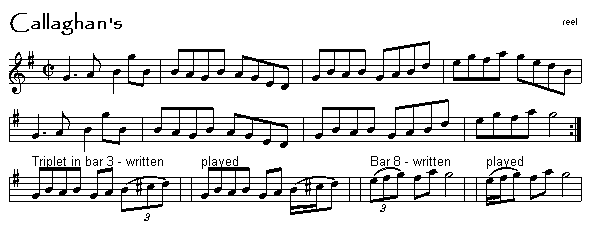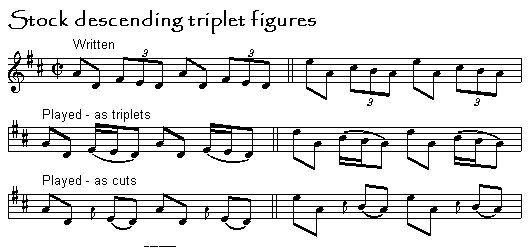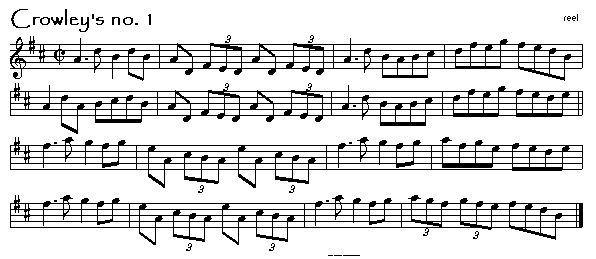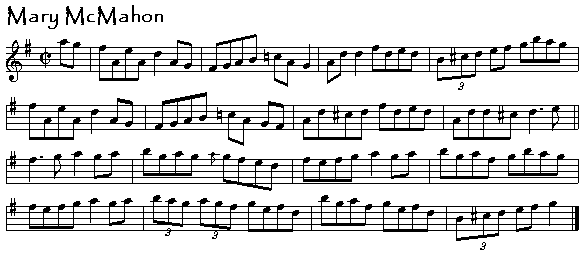Triplets
The term "triplet" in music often means a group of three notes played in the space of two: for example, a quarter note divided into three equal notes. In Irish music, the term is used to mean a variety of different decorations - most of them not true triplets in the above sense.
The ones I'm going to talk about are listed in the menu.
Triplets to decorate quarter notes
This is probably the closest thing to a true "three into two" triplet I"m going to discuss. It's just a handy way of decorating a quarter note - more relaxed than a short roll.
Let's look at an example.

In bar three of this tune, there is a quarter note f# followed by an eighth note e. Bar 7 could be played exactly the same, except that here I have decided to decorate the quarter note f# with a triplet. (The little 3 under the group of notes indicates that three notes have to be spread out evenly over the quarter note.)
You could do this by lifting your f# finger, or - as I have chosen to do here - by lifting the G finger. The A finger would work, too. Each of these possibilities will give you a slightly different effect. Try them all. Also, I am tonguing the f# with the triplet. I needn't have, but I prefer to.
Here's a sound clip.
|
|
First line of Bill Collins' jig, with triplet in bar 7 (44K). |
|
|
A cut on our f#, played twice, followed by a triplet, played twice (32K). |
An example of this kind of triplet is shown in the second part of The maid behind the bar on the Tonguing page.
Ascending triplets in reels
Triplets are used occasionally in reels to "fill in" an interval between two ascending eighth notes. For example, instead of playing two eighth notes, Bd, you might decided to "fill in" the interval with a c#, thus: Bc#d.
The first thing to realize about this trick is that, despite the fact that conventional triplet notation is almost always used, in practice the three notes are not all equal in length. In fact it would be more accurate to notate such figures as two sixteenth notes followed by an eighth note.
Here's an example.

Bars three and seven of this tune end with a Bd eighth-note pair. In the third line of music, I show how you could substitute a Bc#d triplet for this passage. But note that although you will probably see it written as a triplet, you will hear it played as two sixteenth notes followed by an eighth note.
Bars four and eight begin with an eg eighth-note pair. Here we can fill in the interval with an f#, as shown in line 3.
|
|
Clip of bars 3 and 8 - unornamented first, and then with the triplets (33K). |
|
|
The first line of the tune (44K). |
Descending triplets in reels
Just as you'll find ascending triplets in reels, descending triplets are also commonly used - more commonly, in fact. Again, the conventional triplet notation is misleading. Let's look at some common figures that crop up in reel after reel.

Figures like those shown in the first line of music are very common. As we saw in the section of ascending triplets, a more accurate notation would be that shown in the second line of music.
The third line of music shows another possibility. You'll find, as you play these triplets faster and faster, that they begin to sound more and more like cuts. At some point you may simply start thinking of them as cuts, which are much easier to play. I certainly do... Below is a sound clip to try to demonstrate what happens as you get up to speed.
|
|
Stock triplets morphing into cuts (44K) |
Here's a trick to help you convert triplets into cuts: remove the first note from the triplet group as written. Then cut the next one, using whatever finger you would normally use to cut that note. Thus the F#ED triplet becomes {cut}ED, lifting the G finger to cut the E. The c#BA triplet becomes {cut}BA, lifting the B finger to cut the B.
Once you get the hang of this "triplets as cuts" idea, certain passages start to make more sense - and become much easier. Especially when you get more than one triplet in succession - as in the last bar of the next tune.

This tune demonstrates not only the figures we looked at above, but the use of two consecutive sets of "triplets" (actually played as cuts). The last bar of the last line is in fact merely a variation on the last bar of the 3rd line of music. The graphic below shows how these would probably be written, and how I play them.

|
|
Crowley's no. 1, with lots of descending triplets played as cuts (88K). |
Here are a couple more examples:

This is a tune played by Miko (or Micho - pronounced "Mike-O") Russell. I like to slip a couple of triplets into the second part. These ones are a tone higher than those we had in Crowley's no. 1.
|
|
Mary McMahon (??K - clip not posted yet). |

The second line of the well-known reel. I like to put in a couple of these triplets as shown in bar three.
|
|
Second line of The boys of Ballisodare (??K - clip not posted yet). |
Triplet runs in hornpipes
Coming soon.
Tongued triplets and "trebles"
Coming... one day
"Quadruplets", etc.
Coming soon. (If you believe that, don't buy a used car.)
Next page: Crans
Previous page page: Short rolls
Site contents: Back to the home page
Updated: 21 October 2004

